ISSN ONLINE(2319-8753)PRINT(2347-6710)
ISSN ONLINE(2319-8753)PRINT(2347-6710)
Pravin Gudale1 and Dr.Vinayak Naik2
|
| Related article at Pubmed, Scholar Google |
Visit for more related articles at International Journal of Innovative Research in Science, Engineering and Technology
Failure Modes and Effects Analysis (FMEA) is methodology for analyzing potential reliability problems early in the development cycle, where it is easier to take actions to overcome these issues & thereby enhancing reliability through design. A process or a design should be analyzed first before it is implemented and also before operating a machine the failure modes and effect must be analyzed critically. This paper deals with design failure mode & effect analysis ,for development of semiautomatic averaging fixture for engine cylinder block. Different issues associated with engine block averaging fixture are pointed out with there effective failure modes. Prioritization is done on the basis of risk priority numbers ,also most potential risks are identified & minimized. This results in major cost savings along with prestige? towards customer end in terms of quality features. The FMEA is a proactive approach to solve potential failure modes.
Keywords |
| Failure Mode & Effects analysis, Semiautomatic Averaging Fixture, Engine Cylinder Block, Risk Priority Number, DFMEA. |
INTRODUCTION |
| Failure mode and effects analysis (FMEA), first developed as a formal design methodology in the 1960s by the aerospace industry (Bowles & Pelaez, 1995), has proven to be a useful and powerful tool in assessing potential failures and preventing them from occurring (Sankar & Prabhu, 2001). It is an analysis technique for defining, identifying and eliminating known and/or potential failures problems, errors and so on from system, design, process, and/or service before they reach the customer (Stamatis, 1995). [1]. |
| A failure modes and effects analysis (FMEA) is a procedure in product development and operations management for analysis of potential failure modes within a system for classification by the severity and likelihood of the failures. A successful FMEA activity helps a team to identify potential failure modes based on past experience with similar products or processes, enabling the team to design those failures out of the system with the minimum of effort and resource expenditure, thereby reducing development time and costs. It is widely used in manufacturing industries in various phases of the product life cycle and is now increasingly finding use in the service industry. Failure modes are any errors or defects in a process, design, or item, especially those that affect the customer, and can be potential or actual. Effects analysis refers to studying the consequences of those failures. |
LITRATURE SURVEY |
| Some of theories or available literature on FMEA methodology is briefly explained as below. |
| In this paper [2], authors reviewed about different risk evaluation approaches in failure mode & effects analysis. They explained that, the conventional risk priority number (RPN) method along with various risk priority models have been proposed in the literature to enhance the performance of FMEA. In this paper [3], authors propose a failure analysis method by integrating the Failure Mode Effect and Criticality Analysis (FMECA) and Failure Time Modelling (FTM) based on Proportional Hazard Model (PHM). The objectives of FMECA application are twofold: to classify the censored and uncensored data based on the criticality measure of FMECA, and to identify possible external factors (covariate effects) based on cause and effect assessments of FMECA.FTM based on PHM is applied to analyze statistically the censored and uncensored failure time data by considering the effects of external factors. |
| In paper[4],authors explained about A framework of a fuzzy FMEA (failure modes and effects analysis) based evaluation approach for new product concepts that can assist inexperienced users to perform FMEA analysis for quality and reliability improvement, alternative design evaluation, materials selection, and cost assessment, thus helping to enhance robustness of new products at the conceptual design stage. In paper [5], authors explained about risk priority evaluation of the failure modes of rotor blades of an aircraft engine. The results of this case study Show that the proposed FMEA approach is more flexible and reasonable for real applications. |
| Customers are placing increased demands for high quality, reliable products. The increasing capabilities and functionality of many products are making it more difficult for manufacturers to maintain the quality and reliability. These are techniques done in the late stages of development. The challenge is to design in quality and reliability early in the development cycle. FMEA is used to identify potential failure modes, determine their effect on the operation of the product, and identify actions to mitigate the failure. A crucial step is anticipating what might go wrong with a product. While anticipating every failure mode is not possible, the development team should formulate as extensive a list of potential failure modes as possible. The early and consistent use of FMEAs in the design process allows the engineer to design out failures and produce reliable, safe, and customer pleasing products. FMEAs also capture historical information for use in future product improvements. [6] |
| As very less work is done in field of development of semiautomatic averaging fixture, current paper deals with use of FMEA methodology for this fixture before manufacturing. |
| This paper is organised in different sections as fallows, |
| Section III represents FMEA overview, section IV represents importance of semiautomatic fixture for engine cylinder block, Section V deals with case study of averaging fixture where ten steps of FMEA are discussed along with design FMEA chart. Section VI presents results &discussions on case stud followed by Section VII which concludes about use of FMEA methodology. |
FMEA OVERVIEW [7] |
| An FMEA (Failure Mode and Effect Analysis) is a systematic method of identifying and preventing product and process problems before they occur. FMEAs are focused on preventing defects, enhancing safety, and increasing customer satisfaction. Ideally, FMEAs are conducted in the product design or process development stages, although conducting an FMEA on existing products and processes can also yield substantial benefits. |
Purpose of FMEA :- |
| Preventing process and product problems before they occur is the purpose Of Failure Mode and Effect Analysis (FMEA). Used in both the design and manufacturing processes, they substantially reduce costs by identifying product and process improvements early in the develop process when changes are relatively easy and inexpensive to make. The result is a more robust process because the need for after-the-fact corrective action and late change crises are reduced or eliminated.Under the seven assessment categories of The Partnering for Total Quality Tool Kit, FMEA is recommended along with Process Analysis Technique, Design of Experiments and Fault Tree Analysis, as a part of quality assurance that a company should use systematically for total quality control. All indicators from the total quality management perspective and from examination of the equipment life cycle tell us that the FMEA works best when conducted early in the planning stages of the design. However, the FMEA is an iterative process that should be updated continually as the program develops. |
Types of FMEA :- [8] |
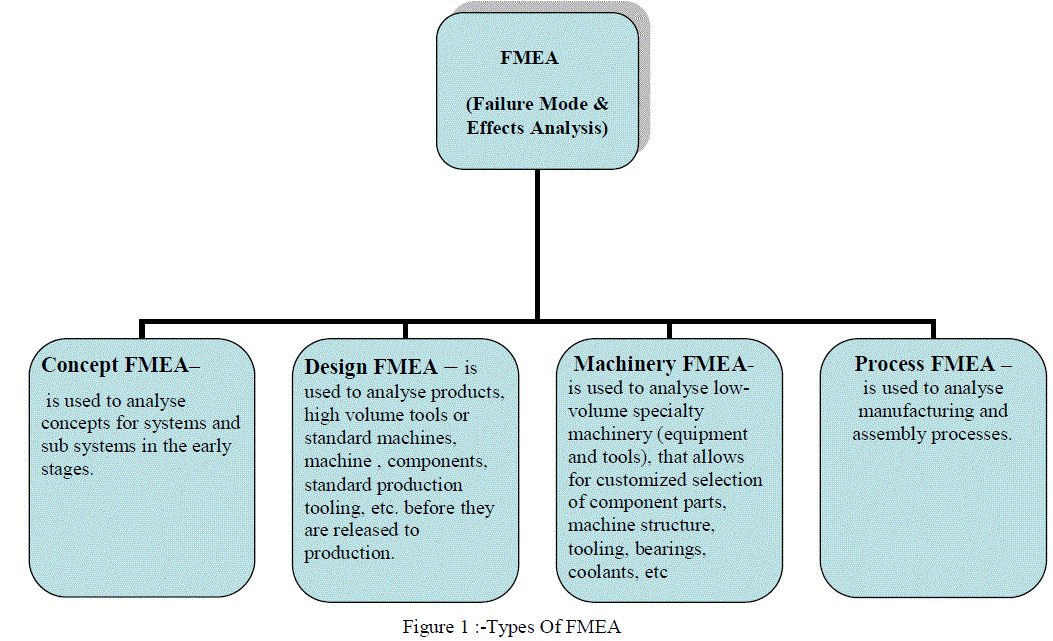 |
| Out of above mentioned four types Design FMEA is used for analysing failure modes coming before implementation of averaging fixture for engine cylinder block. |
IMPORTANCE OF SEMI AUTOMATIC AVERAGING FIXTURE FOR ENGINE CYLINDER BLOCK. |
| After the casting is made, it is send to machine shop for machining as required by customer. It is necessary to ensure that minimum machining allowance is available on all the machined faces before machining the first references in all 3 axes. Subsequent machining is done with respect to the first machined references. This activity of ensuring availability machining allowances is done by marking the casting on a layout marking machine for small quantity of casting .Since this is time consuming activity for mass produced castings, averaging fixtures are used in such cases. Hence averaging fixtures should logically have features to ensure minimum machining allowance and facility to conduct first machining references in 3 axes. |
| Normally 3 small machined pads in one axis and 2 dowel holes on these pads are sufficient to locate the casting, constraining all the three degrees of freedom for subsequent machining either on transfer line or gang of SPM’s. This operation of averaging is mainly done on radial drilling machine. |
| By taking into consideration point of averaging fixture for engine cylinder block, old type design of averaging fixture is very complicated .This practice of creating averaging references on casting in 3 axes is very skilled ,very time consuming and tedious process. |
| Also in order to meet customer requirement for supply of castings, manual averaging fixture is not found much suitable because doing machining operation with such type of fixture contains problems such as more cycle time for operation with less productivity , Averaging dowel holes centre distance variation due to hinge type design , Fatigue to operators while loading of job inside fixture ,Manual clamping , Visualization of template profiles while setting of job, Fatigue to operator for template pushing & pulling, Any mistake proofing’s or poka yokes is not existing , Not easy to inspect fixture for calibration to quality persons, Setting of fixture on machine at time of setup change over is not easy, Maintenance of screw jacks & other parts is time consuming, heavy type of alignment gauge to inspect centre distance of averaging dowel holes. Hence is in needed to overcome above mentioned drawbacks in manual avg. Fixture. |
| This generates Need of Semiautomatic Averaging Fixture for improvement of productivity, reducing rejection with quality improvement & customer satisfaction, reducing fatigue to operators. |
CASE STUDY ON DESIGN FMEA FOR SEMIAUTOMATIC AVERAGING FIXTURE OF ENGINE CYLINDER BLOCK. |
| All product/design and process FMEAs follow ten steps. Firstly we have to identify the requirement/function to be performed. Potential failure modes are then identified with their effects. Depending on impact of failure severity ranking is given .After this evaluation of Occurrence & detection numbers is done. By multiplying severity,Occurance &detection Risk Priority Number is calculated. Actions are assigned to higher RPNs to reduce risks of failure. In this way after completion of actions again RPN is calculated & compared with original RPN. Also the process is documented for further related work. |
| Fig.no2 shows ten steps in FMEA . Schematic diagram of proposed semiautomatic averaging fixture for engine cylinder block is as shown in fig.no.3 . |
| Also Table no.3 shows DFMEA (Design failure mode & effects analysis) for this averaging fixture as follows, |
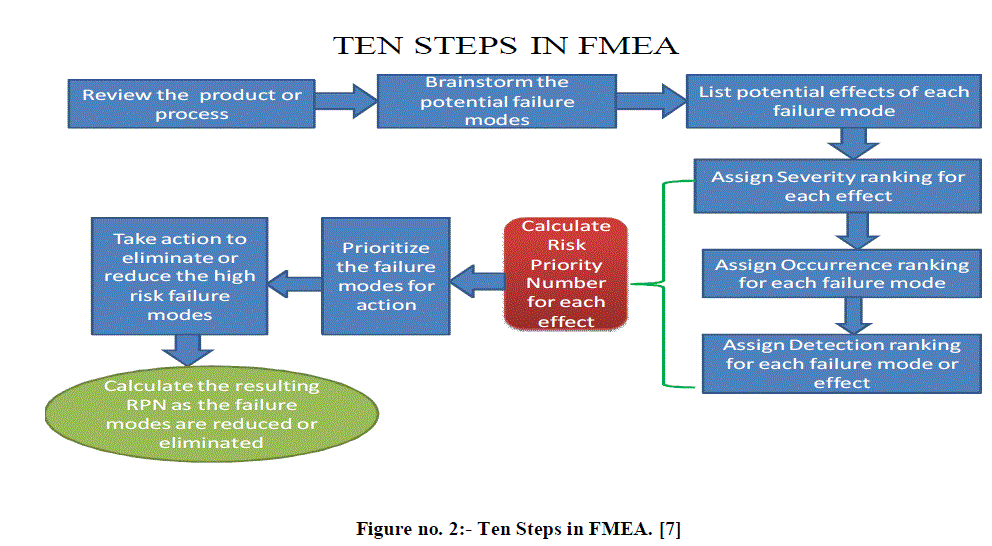 |
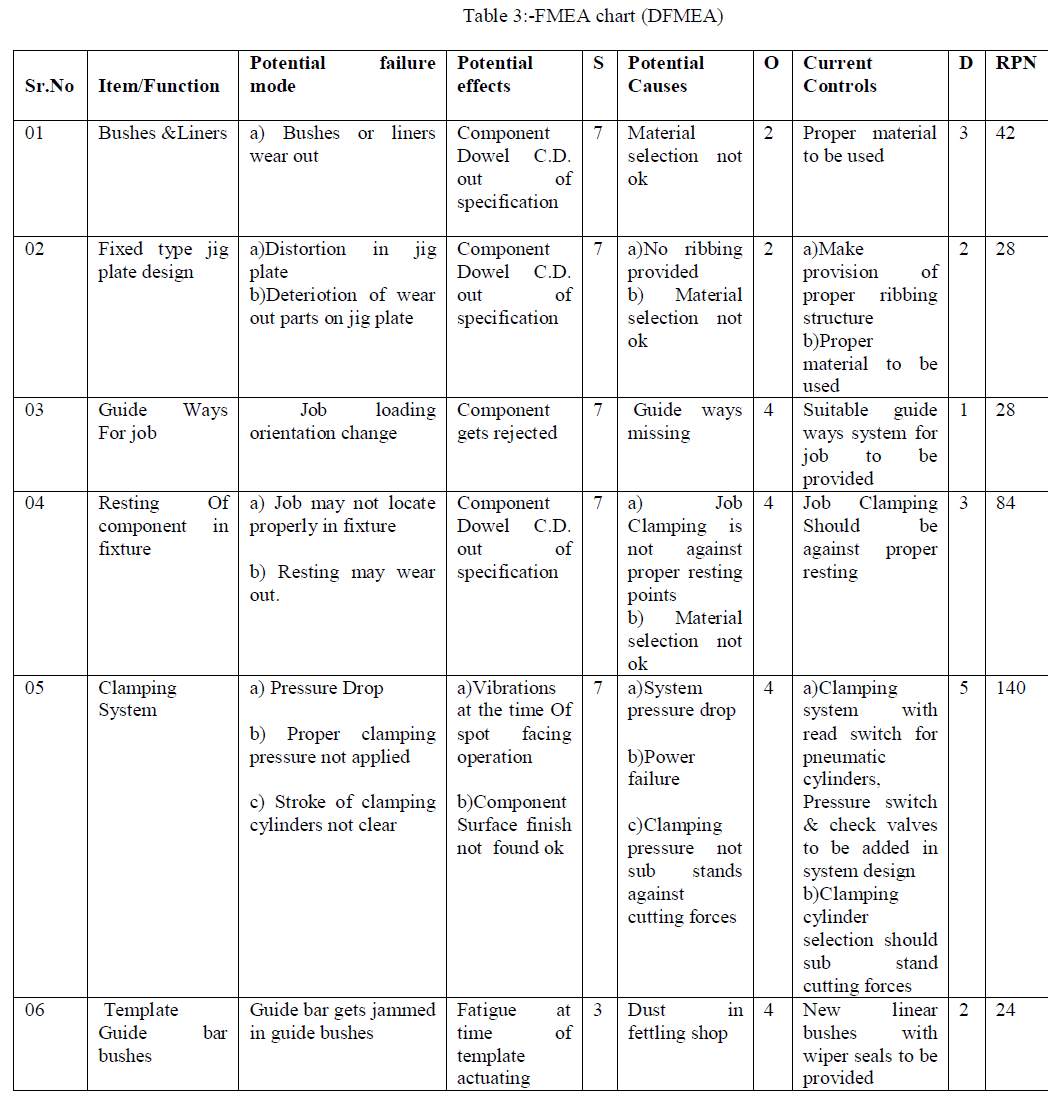 |
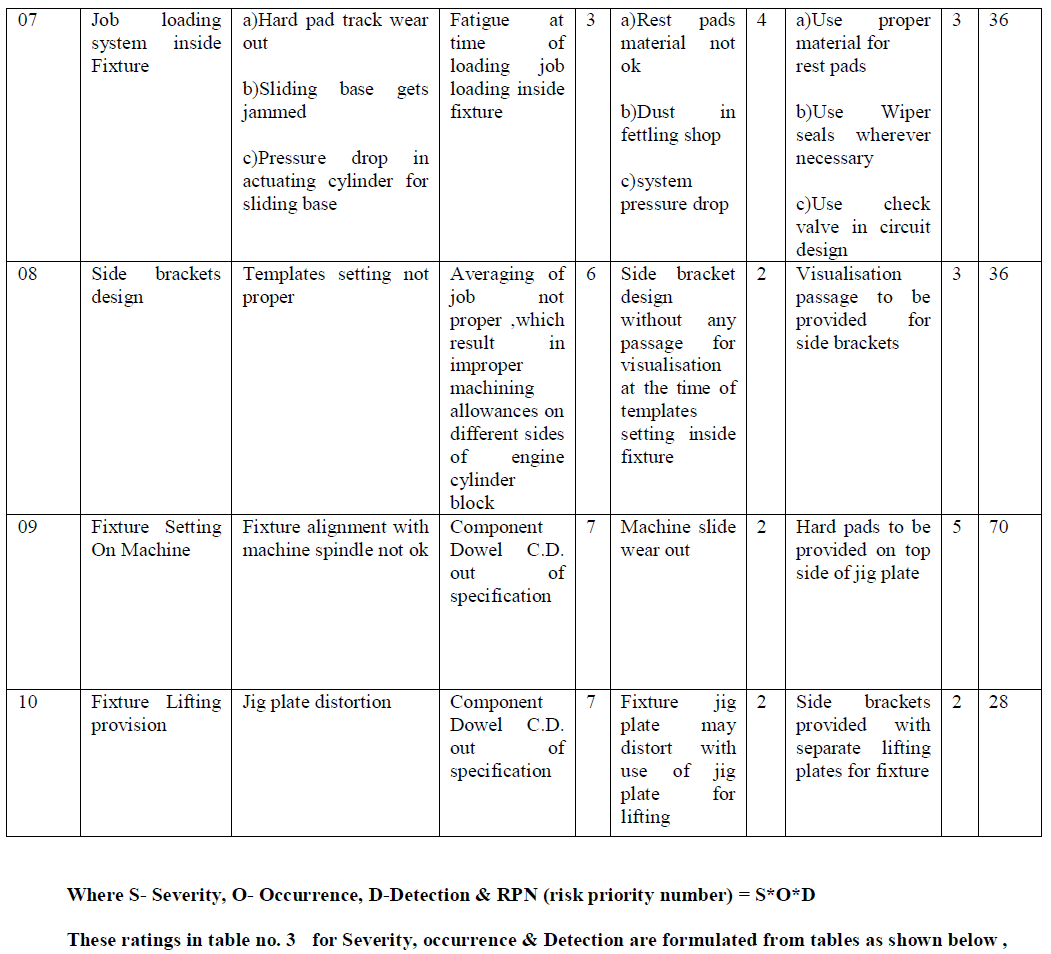 |
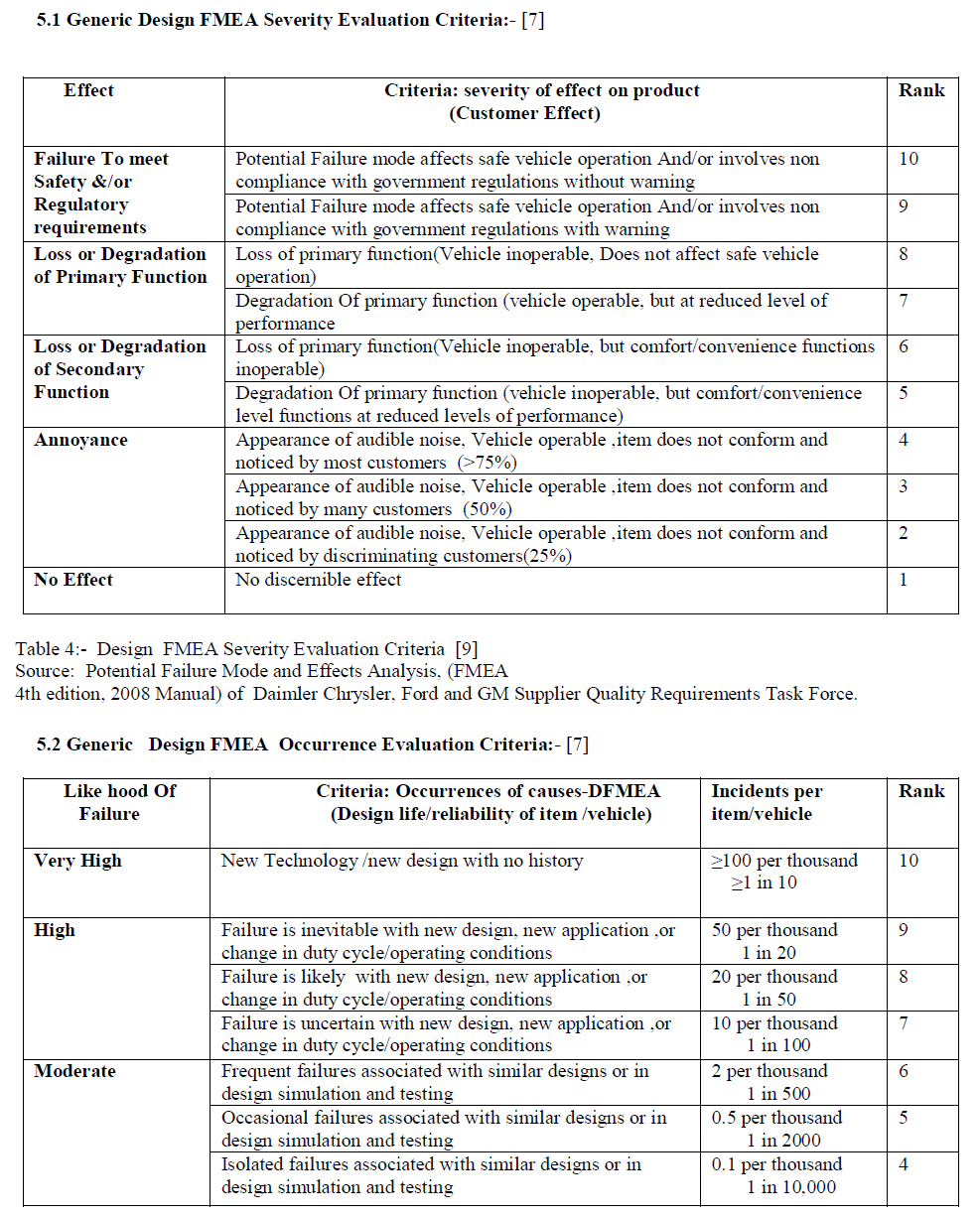 |
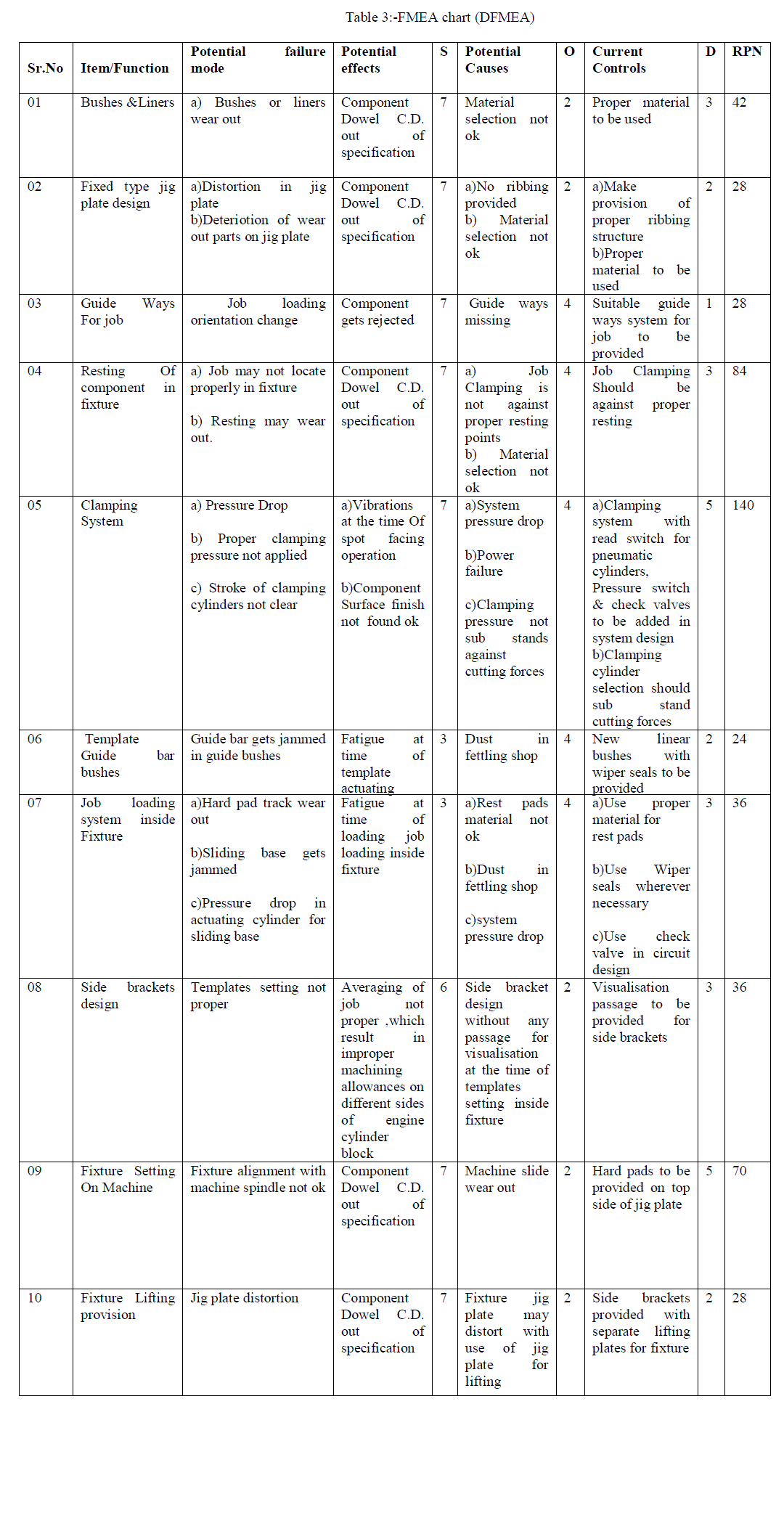 |
Proposed action for higher RPN failure mode (Simulation Section):- |
| As discussed above in FMEA chart (Table No.3) RPN for pneumatic clamping system is 140 ,which is higher out of all failure modes. So this system is simulated by using studio-automation software. Fallowing fig.no.4 shows layout of proposed clamping system in averaging fixture. This represents that if there is pressure drop in system, pressure switch will give signal to machine spindle to stop. Also if stroke of pneumatic clamping cylinders is not completed, signal is given to machine spindle via read switches to stop. From trouble shooting point of view , it is fond that if 5/2 solenoid operated direction control valve get stuck up or if there is malfunction of pressure switch then there are chances of failure of this circuit, So check sheet for maintenance is also updated at initial stage of design of fixture. |
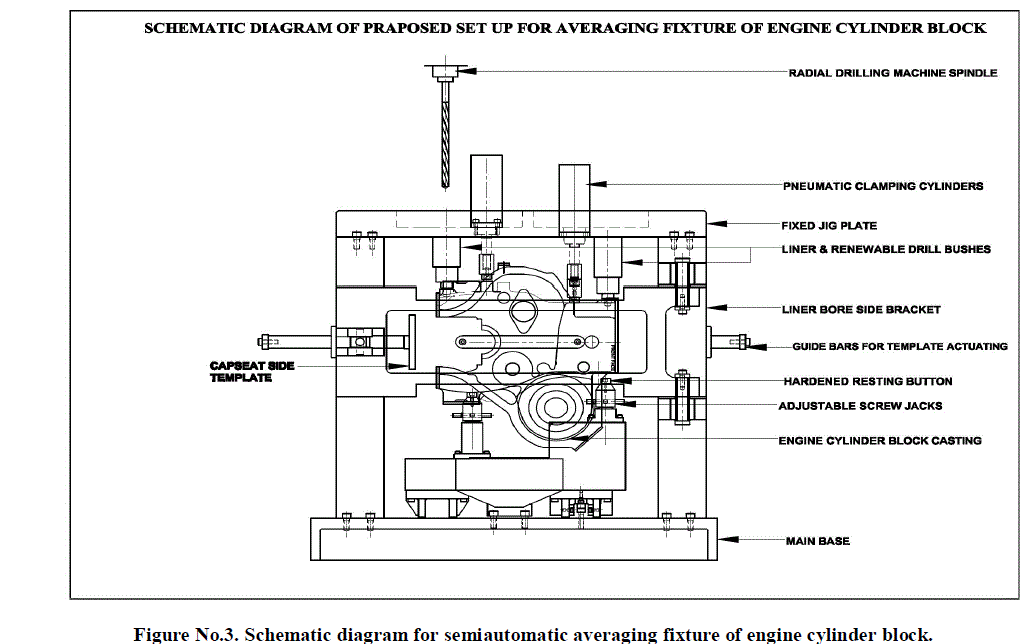 |
RESULTS & DISCUSSIONS |
| RPN play an important part in the choice of an action against failure modes. They are threshold values in the evaluation of actions for these failure modes. Total ten items/functions of semiautomatic averaging fixture for engine cylinder block are analysed. Out of these ten, two failure modes clamping system & resting of component in fixture are found higher RPN.For clamping system risk priority number (RPN) becomes 140(where S = 7,O = 4,D = 5) , Thus corrective actions like clamping cylinder selection strictly against cutting forces , pneumatic circuit design with read switch for clamping cylinders, pressure switch & check valves are taken in design stage which resulted in reducing RPN from 140 to 28 (Where S = 7, O = 2 & D = 2).Also, RPN for resting of component in fixture found to be 84(where S = 7,O = 4,D = 3).Thus actions like proper resting of component against clamping ,suitable material for pads etc. are taken in design stage which resulted in reducing RPN from 84 to 14 (Where S = 7, O = 2 & D = 1). |
| Once these actions for failure modes with higher RPN are taken , corrective actions for failure modes with lower RPN are also implemented, which resulted in minimizing both major & minor risks associated with design of fixture. Thus DFMEA resulted in giving unique design for averaging fixture at early stage of design. |
CONCLUSION |
| Thus in this paper , Semiautomatic averaging fixture for engine cylinder block is analysed & expected failures are noted. This analysis will be useful for anyone who will manufacture these kind of averaging fixtures. The corrective actions should be taken before manufacturing of averaging fixture. The integrated approach, FMEA serves as better tool for making fixture most defect free .It is found that most important parts with higher risks like, clamping system for which RPN reduced from 140 to 28 & Resting for component provided in fixture for which RPN reduced from 84 to 12. |
| So use of FMEA tool will result in reduction of higher risks in design at early stages, reducing cost of manufacturing & giving sound quality of averaging fixture for engine cylinder block. |
ACKNOWLEDGEMENTS |
| I take this opportunity to thank my guide Prof.Dr.V.R.Naik for his valuable guidance and for providing all the necessary support for completion of analysis for semiautomatic averaging fixture for engine cylinder block. |
References |
|